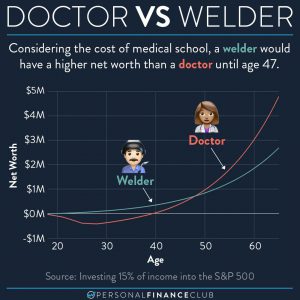
When people talk about stocks and the stock market, they almost always talk about the share price of those stocks. “The market is up”, “Tesla is at…”, “Buy the dip”… Those are all focused on the price of a stock or the price of an index that tracks the stock market.
While share price is exciting, there’s another wealth generating factor at work: Dividends. The stocks of profitable companies often pay dividends. They’re cash payments made to the shareholder, usually quarterly. They’re usually not very exciting amounts. A share of Apple stock is currently trading at $116. The annual dividend? Just $0.82. That’s about 0.72% of the share price.
The entire US stock market currently is paying about a 1.63% dividend yield. Still not a very impressive number.
But look at these charts. Going back 40 years, if you ignore dividends (just flush them down the toilet) you end up with only 36% of the amount you would have if you reinvested those dividends. Even taking the dividends and putting them in a high yield savings account only grows to about HALF of the invested amount. And in this chart I’m using the actual historical interest rates for a savings account. Those rates exceeded 15% in the early 80s! Even at THOSE crazy high interest rates on the dividends, reinvesting the dividends still DOUBLED the performance. Bananas.
But don’t go too far the other way. If you chase dividends (buying just stocks that pay high dividends) you’re reducing the diversification of your portfolio and missing out on high growth stocks that don’t pay dividends (Amazon, Google, Netflix, Berkshire, Chipotle, etc.).
So what to do? Once again, the optimal path to wealth is the boring one. Buy and hold index funds. Reinvest the dividends. Never sell. Making it more simple will make you more wealthy.
As always, reminding you to build wealth by following the two PFC rules: 1.) Live below your means and 2.) Invest early and often.
-Jeremy
via Instagram

 September Sale!
September Sale! 



